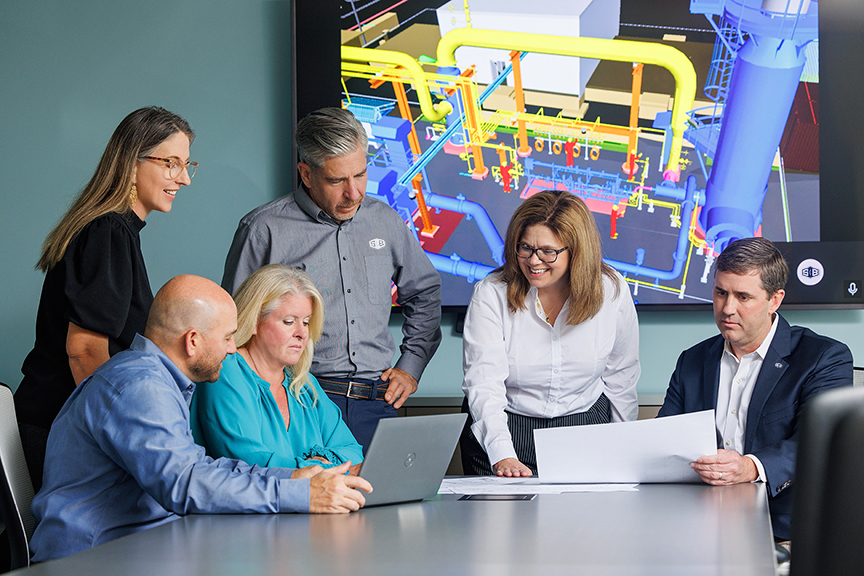Tariffs, including a 50% duty on most steel and aluminum imports, are expected to raise construction material costs within six to nine months significantly. Key materials such as copper, lumber and cement may also face pricing volatility due to supply chain ripple effects. To navigate this evolving landscape, project owners must partner with the right engineering, procurement and construction (EPC) partner for early planning, disciplined procurement and transparent supplier engagement to stay on track and budget.
Navigate Tariffs with Confidence
Tariff conditions can shift rapidly. The right partner needs to monitor policy changes in real-time and engage directly with suppliers to understand the actual impact on materials and equipment. When tariffs change due to legislative or regulatory shifts, tariffs may be treated as a change in law or force majeure if the contract is structured to allow for economic price adjustment. Such provisions may help maintain contractual balance by allowing reimbursement of tariffs to suppliers or credits to the customer if tariffs decrease. Require suppliers to list tariff estimates separately in their quotes, provide early notification of any tariff impacts, and supply clear justification documentation if requesting reimbursement of any tariff-related costs.
A capable EPC partner also requests that suppliers include references to any known tariff codes or regulatory changes in effect at the time of their offer and disclose the shipping points of origin, which will help identify any potential tariff exposure. This approach ensures transparency, separates tariff risk from base pricing and protects customers from inflated assumptions.
Early EPC Involvement Controls Costs
Material prices often rise after teams estimate a project but before they make final purchases. An experienced EPC partner can manage this uncertainty by aligning purchasing timelines with the project schedule and factoring escalation into early cost models. For example, in a recent project, an energy customer required a clear understanding of costs, despite contracts still being finalized. They were facing rising material prices, high tariffs and ongoing global negotiations that added uncertainty to their planning process. S&B stepped in early with detailed, open-book estimates and transparent cost breakdowns to allow the customer to make informed decisions without waiting for final commercial terms.
S&B worked collaboratively to establish agreed-upon markups and engaged suppliers early to secure pricing. This approach provided the customer with cost certainty and enabled S&B to align labor and procurement strategies behind the scenes. As soon as the project received approval, S&B advanced immediately without rescoping or rebidding, saving months of effort and helping the customer avoid delays during a critical stage.
Smarter Logistics Solutions
Experienced EPCs often optimize strategic tools like bonded warehouses and Foreign Trade Zones (FTZ) to mitigate risks associated with global sourcing of material and equipment. These facilities allow imported material and equipment to be stored without incurring immediate duties or tariffs. For example, one project leveraged bonded storage for Canadian-sourced equipment subject to a 25% tariff. By delaying final customs clearance, the team avoided the immediate tariff and time the delivery to align with more favorable trade conditions. This approach not only reduced costs but also safeguarded the project schedule from potential delays.
Strategic Advantages of the Right EPC Partner
Several EPC capabilities can provide a strategic edge in today’s market:
- Direct-hire labor for better control over availability, cost and productivity.
- Lump-sum pricing provides greater cost certainty for the customer.
- Established supplier relationships that provide early insight into material availability, price movements and lead-time risks before they reach the project.
- Modular construction support to improve delivery flexibility and reduce risk.
- Construction-only execution that supports a range of contracting strategies, including collaboration with other engineering providers, FEED packages and shelved projects, to accelerate delivery.
Plan with Purpose
Today’s projects must contend with market volatility, changes in law, labor dynamics and trade uncertainty. A qualified EPC partner addresses these challenges head-on, not through guesswork, but through current data, supplier alignment and disciplined execution.
Project owners who engage the right EPC firm early gain greater control, avoid costly missteps and keep critical initiatives on track. With the right partner, even the most complex environment becomes manageable.
Contact S&B’s Procurement experts today to learn how we help customers navigate uncertainty with confidence.





